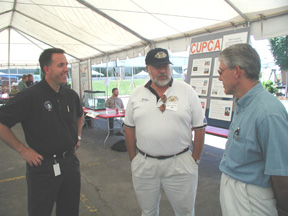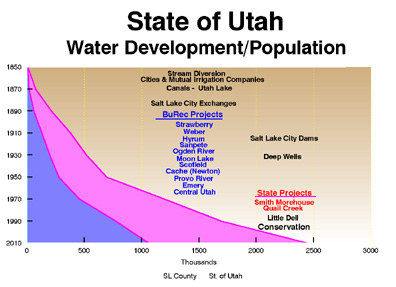Bureau of Reclamation Centennial Year Celebration
Western federal water development projects have helped build a nation
LeRoy W. Hooton, Jr.
June 9, 2003
|
This past year BOR has been celebrating the Actís century mark by holding a series of open house events. The kickoff celebration was held at Hoover dam last year, BOR's centerpiece water development project. The Utah Regional Office held its open house on Friday June 6, at its Provo Office with speeches, hot dogs, the 23rd Army Brass Quintet and various project displays. The theme ďA Century of Water for the West" was to be hosted by Reclamation Commissioner John Keys, but he was called to Denver to attend a conference with water interests and Secretary Gale Norton, to discuss Nortonís Water 2025 program.
Itís easy to imagine that President Roosevelt would have been pleased, if not surprised, with the results of this turn-of-the-century legislation. The dams and conveyance systems built by the BOR probably far exceed the expectations of Roosevelt and those early visionaries who worked for federal legislation as a means to reclaim the arid West. The West under the Act includes the 17 western states located west of the hundredth meridian, an imaginary line which bisects the United States running north to south passing through points west of Wichita, Kansas; Oklahoma City, Oklahoma; and Fort Worth, Texas.
Substituting for Commissioner Keys, BOR director of operations, Bill Rinne, told the assembled audience that BOR projects provide water to 31 million people; grow 65 percent of the nationís vegetables; 25 percent of the nationís fruits and nuts; and deliver electrical power to 3.5 million homes. However, he noted that the role of the Bureau is changing; the days of large dam projects are over and the Bureau is now focusing on managing its existing facilities in an efficient and environmentally sound manner.
Promoting BORís most recent inititive, ďWater 2025,Ē Rinne said the program is intended to spawn a vigorous discussion to refocus on water and the BOR. Rinne noted that the West is experiencing a population explosion and new solutions are needed to spread existing water supplies around. Utahís population increased by 30 percent this past decade. Arizona grew by 40 percent and Nevadaís population was the fastest growing in the nation at 66 percent. The Wasatch Front has been identified as one of the western areas expected to have future water problems. A Water 2025 meeting is scheduled for Salt Lake City on July 16.
|
The 1935 Provo River Project and 1964 Central Utah Project provide water supply to Salt Lake County. Formed in 1934 by Salt Lake City, the Metropolitan Water District of Salt Lake & Sandy (Metro), owns 61.7 percent of the shares in the Provo River Water Users Association, and is entitled to 61.7 percent of the annual water supply from the project. Metro also has an approved petition for 20,000 acre-feet of Central Utah Project Bonneville Unit water supply.
Metro participated in the celebration with a booth highlighting the Provo River Project and the Salt Lake Aqueduct. Old photographs of the project were displayed on a large computer screen.
Much has changed since the 1902 Reclamation Act was passed by Congress. The United States population in 1900 was 76 million. The 2000 census figures counted 276 million Americans, a 263 percent increase. Unquestionably, federal water development contributed significantly to the building of the West and the might of the United States. Future Americans may not know about San Juan Hill, but through the BORís institutional memory, they will be reminded about Teddy Roosevelt and the federal water development programs of the twentieth century.

